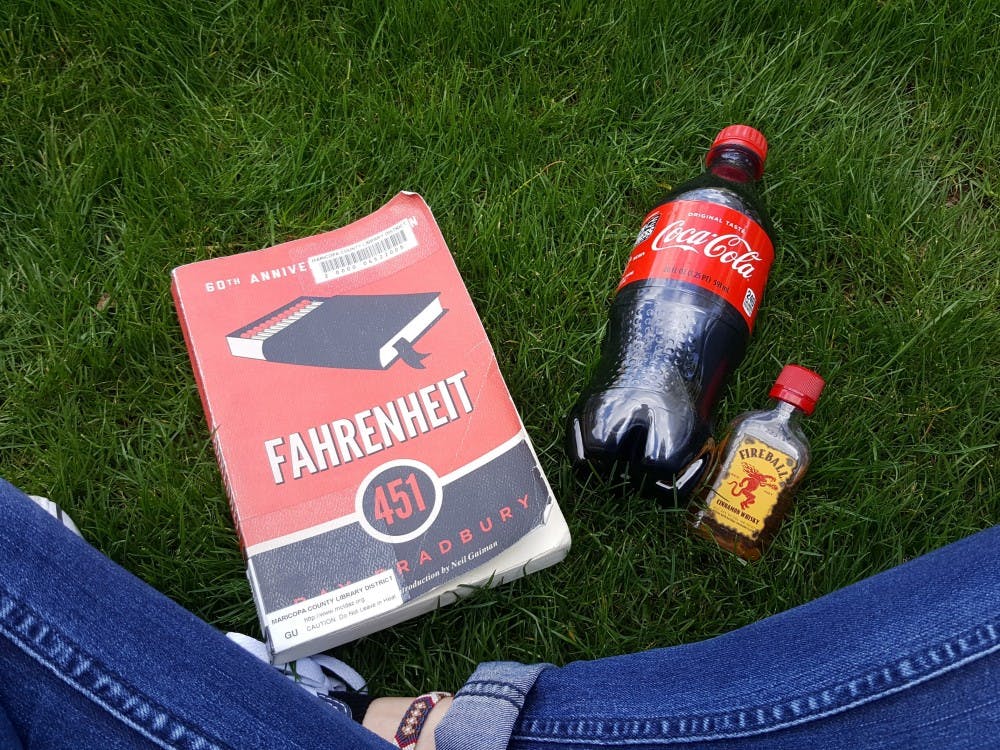Continuing a series started by former reporter and current digital editor Carson Abernethy in 2016, the arts and culture editors will drink their way through great works of literature, reviewing books and the booze that inspired them.
The 1953 novel “Fahrenheit 451," fueled by the author Ray Bradbury's concerns about the threat of the U.S. succumbing to book burning during the McCarthy Era, is a classic dystopian novel where that fear has become a reality.
“Fahrenheit 451's” main character is firefighter Guy Montag and the book takes place in an unspecified time period where houses are no longer flammable. Because there is no need to put out fires, firefighters now start them — burning books and book owners' houses down with them.
A fiery twist on a classic Whiskey and Coke, Fireball Whiskey and Coca-Cola pair perfectly with the metaphor of fire embedded through the novel and the internal conflict Montag experiences.
Recipe:
The recipe for this drink is simple, just pour Coke and Fireball Whiskey over ice. However, for extra fire and flair, the whiskey can be set on fire beforehand, which is said to improve its taste (and looks pretty cool).
In the world of “Fahrenheit 451,” books, along with paintings and all other relics of the past, are outlawed and strictly taboo, and the novel details the downfalls of mankind in a society deprived of literature and with no knowledge of the past.
After Montag’s mysterious, old-for-her-years neighbor disappears and he finds his wife passed out after overdosing on sleeping pills, he begins to read in secret until the fire-chief finds out and burns down Montag's house.
With a warrant out for his arrest and a mechanical hunting dog after him, Montag must flee the city in search of other readers to help him repair society and restore its humanity.
Prose: 5/5
The writing in “Fahrenheit 451” flows almost like a song, as the way Bradbury describes the scenes in the novel pushes the story forward. Though in third person, the audience is aware of Montag’s thought processes and every scene is described with incredibly vivid imagery, making it enjoyable to read and full despite its brief length.
Additionally, the novel is a case study in using fire as a metaphor, and Bradbury cleverly uses symbolism to thread fire through the entire novel.
Characterization: 4/5
All of the characters in the novel besides Clarisse McClellan are flat and one dimensional, but Bradbury does this intentionally to demonstrate how drained of life society has become after banning anything reminiscent of the past. McClellan is Montag's mysterious almost 17 year-old neighbor who prompts him to become curious about books and rethink his life and his views on society.
Fueled by McClellan's disappearance in the first part of the novel, Montag's character development is interesting and nuanced as he realizes the errs of society and works to dismantle what he believes to be a corrupt and dangerous system.
Cohesiveness: 5/5
Written in three acts, the novel flows and is separated well to mirror Montag's character and moral development.
Relevance: 5/5
As technology continues to advance and distrust in the media grows, society may be approaching the dystopian, entertainment addicted future Bradbury imagined over 50 years ago. The New York Times book critic Orville Prescott wrote when it was released that, “Mr. Bradbury’s account of this insane world, which bears many alarming resemblances to our own, is fascinating.”
It’s safe to say that the resemblance is even clearer now than it was in 1953, apparent in the fact that HBO will be releasing a film adaption of the book in spring of 2018 starring “Black Panther’s” Michael B. Jordan as Montag.
Overall: 4.75/5
“Fahrenheit 451” is a widely loved classic that immediately captures reader's attention and speaks to the importance of the marketplace of ideas and government limitations. Using fire as a metaphor in endless capacities, Bradbury brilliantly paints a stunning image of this imagined future to artistically warn about the perils of forgetting the past and the importance of knowledge and individualism.
Read More: Books and Booze: ‘To Kill a Mockingbird’ by Harper Lee
Read More: Books and Booze: 'Brave New World' by Aldous Huxley
Reach the reporter at abpotter@asu.edu and follow @lexipotter04 on Twitter.
Like The State Press on Facebook and follow @statepress on Twitter.




